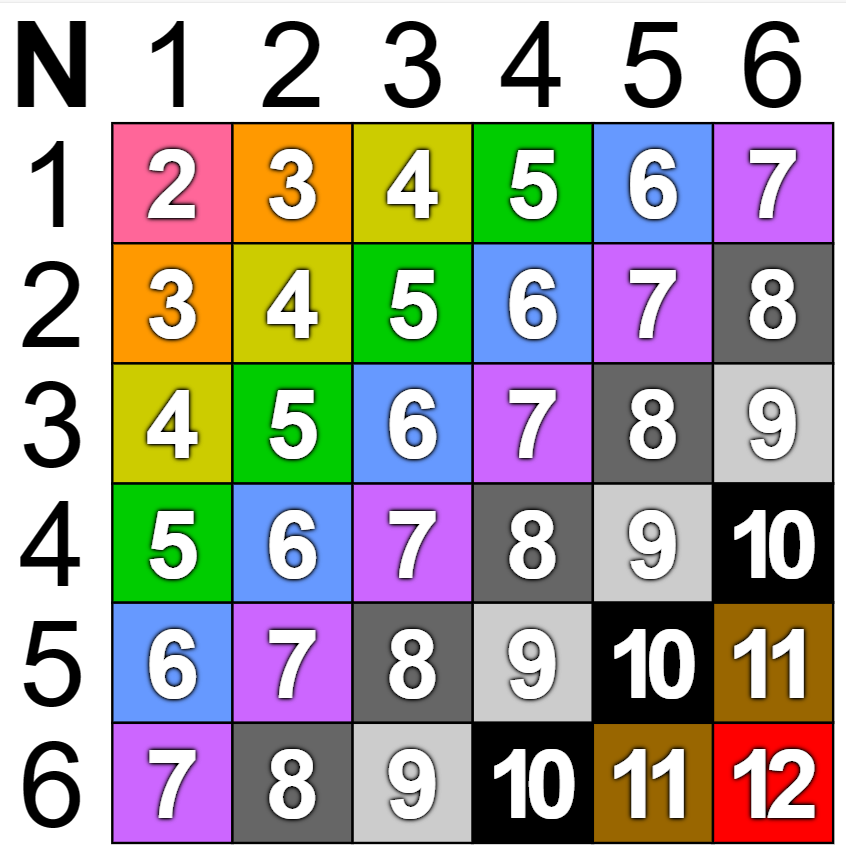Sicherman Dice
A GameTek Stocking Stuffer
I have a lot to talk about in upcoming GameTeks, including the Tabletop Game Designers Association (you can go here for a sneak peek) and my experiences at Tabletop Network a few weeks ago. However, as it is a holiday weekend in the United States, here’s a nice item I hope you will find a tasty morsel.
As you are probably aware, if you roll two standard D6’s, the distribution of the sum of the dice looks like this:
The most common result is 7, which occurs 1/6th of the time. The least likely are 2 and 12, which each happen 1 out of every 36 rolls.
This is the result with two identical D6s, each going from 1 to 6.
Is it possible to have different D6’s that give this exact same distribution? If I can use any positive, integer numbers on the dice, can I replicate this distribution exactly?
The answer, surprisingly, is yes. And there is only one way to do it. This oddity was discovered in the 1970’s by George Sicherman.
The two dice are:
1, 2, 2, 3, 3, 4
1, 3, 4, 5, 6, 8
To show you that this works, here’s a grid of all possible combinations of two standard dice:
You’ll see that there is one way to make a 2 or 12, two to make a 3 or 11, and so on, up to six ways to make a 7.
Sicherman dice have the same numbers in the grid, just in different locations:
A standard D6 has an average value of 3.5. For the Sicherman dice, one die has an average of 2.5, and the other 4.5. This adds up to 7, as one would expect.
If you were playing a game of Catan you could not tell whether you were using Sicherman or normal dice just based on the results. The distribution is exactly the same.
Game Applications
As far as I know, no game has used Sicherman dice. But I could see a wealth of game applications. Perhaps the sum applies to some global effect (resource production, to mirror Catan, for example), but the player can choose either the high or low die to use. Or just plugging them into another game - how would backgammon play with these dice? The chances of getting doubles are lower for one thing - 1/9 instead of 1/6.
What if a player could use the sum of the dice or individual values, but had a choice of rolling normal or Sicherman dice? How could that be used?
Variations
If you’re willing to allow a zero value on the dice there are a few more combinations, formed by subtracting one from the faces of one die and adding one to the faces of the other.
Doing this you can take a standard set of D6’s to create another set:
0, 1, 2, 3, 4, 5
2, 3, 4, 5, 6, 7
and you can create two more from the Sicherman dice:
0, 1, 1, 2, 2, 3
2, 4, 5, 6, 7, 9
or
2, 3, 3, 4, 4, 5
0, 2, 3, 4, 5, 7
Do you have any ideas on how to use Sicherman dice in a game, or are you aware of one that already exists? Let me know in the comments!
Sicherman dice are available for sale from several sources if you want to buy some to play with. Hope this inspires some creativity!





In Combat Commander most die-rolls sum the two dice, but artillery multiply them. Sicherman dice could change the resulting spread and potentially make the artillery less swingy, if that were a design intent.
Personally- I have been working on dice that give different results, based on external conditions.
*example- - IF you have X number of (these) units or less, THEN the results are Y.
BUT--- For my money-
It seems that - if you have a number of (color coded?) dice that are rolled in a particular (or set) sequence--
BUT you could stop rolling them at any time,
THEN you would have a "push your luck mechanism" that could have different potential results -- both in terms of totals, choice of results, potential failures, and ("Yahtzee-like") combinations.
I would suggest a game that requires you to roll two dice, then choose to potentially roll more-- and those other dice are cued up in an order that was potentially effected by (all) players resources previously.
Each player could receive bonus resources from some rolls, #s for potential combos they can build, and "Whammies" that stop their progress..?
You could also use my "If/THEN" style dice, and have the number you receive for a roll in one corner- and the color of the side and the other corner indicate what you might need for your next roll.?
My thoughts-
Matt Zolynsky
Armies of Mythoz Designer